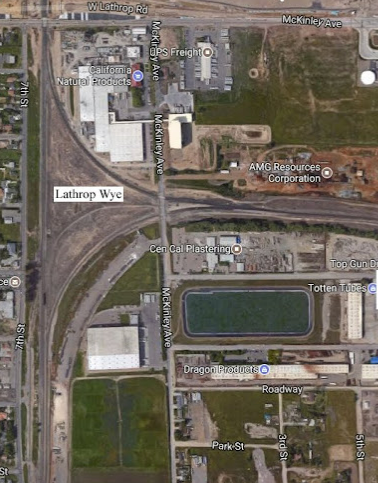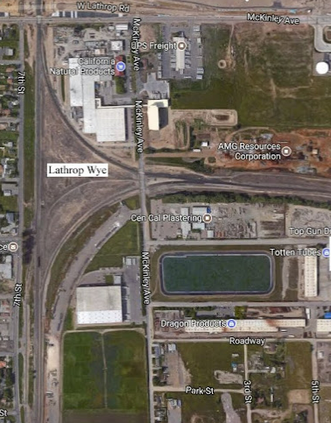The railroad literally gave birth to Manteca and Lathrop as towns some 150 plus years ago.
It’s only fitting that the railroad takes both communities to the next level.
That might seem nonsensical given there are a lot of communities along railroad tracks.
But Manteca and Lathrop are different.
Just like the fact they are on the southeast edge of California’s vast “switching yard” for water movement — the Delta — they are both strategically located at ground zero of two other key intersections that power growth.
The most visible is the 6-mile 120 Bypass connector that joins Interstate 5 and Highway 99 together near Interstate 205, the gateway to the job-rich and well-heeled consumers of the Bay Area.
The appeal of the movement of goods and commuters converging through a concentrated corridor that Manteca-Lathrop offers is reflected in not just the housing growth fueled by Bay Area style paychecks.
It is also underscored by the business concerns that have located their distribution centers and manufacturing plants here: Amazon, Medline, Wayfair, Tesla, Ford, Home Depot, 5.11 Tactical, Lowe’s Home Improvement, In-and-Out Burger, and a list that goes on and on.
It is the same dynamics that have made this the “switching yard” for rail-truck movement of goods with the Union Pacific Railroad intermodal facility wedged between Manteca and Lathrop as well as the Santa Fe Railroad intermodal facility within 10 miles of Manteca to the northeast.
But those two growing linchpins of the movement of goods are Johnny-Come-Lately compared to what is likely to rev up growth in the two cities for the rest of the 21st century, the Lathrop Wye.
It was what literally brought Lathrop into being and gave Manteca additional traction to go from being a wide spot on the road to becoming a trading center.
A “wye” in railroad jargon is where three lines converge. In the case of the Lathrop Wye that touches on the Sharpe Depot on the west, it allows for transitions from the Fresno corridor to the Altamont Pass corridor for freight movements.
In the 19th century short lines (local railroads) as well as competitors to the original builder of the Lathrop Wye which was the Central Pacific Railroad converged on the area.
Among the competition was the Southern Pacific that has long since abandoned its tracks.
The combination of the 120 Bypass, the Lathrop Wye, and the abandoned Southern Pacific tracks are about to make South San Joaquin County the prime exurb when it comes to both the movement of goods and the housing of workers that are fueling Bay Area growth.
The appeal of Manteca-Lathrop to Bay Area commuters is going to step up a notch or two in 2023. By 2028, the proverbial foot will be pressed to the metal.
Just over a yar from now Altamont Corridor Express service will be extended south to Ceres and north to the office-job rich Natomas office area just across the American River from downtown.
It will include stops in Modesto, Ripon, downtown Manteca, the Lathrop Wye, Stockton, and Elk Grove.
It is the Lathrop Wye where a transfer station as well as massive parking lot that may eventually accommodate 3,500 vehicles that is likely to have a mega-impact in the growth projectory of Manteca and Lathrop that already rank among the top 10 fastest growing communities in California.
It is at the Lathrop Wye where you will be able to transfer to an ACE train heading into San Jose. That is on top of one train originating in Ceres on the Fresno Line that will switch to the Altamont line and then head to San Jose without the need to switch trains.
The Wye, coupled with three other ACE trains originating in Sacramento will give Manteca-Lathrop commuters as many as seven train options to reach the promised land of well-paid employment — the Silicon Valley
The main event when it comes to the potential for reviving up Manteca-Lathrop growth is targeted to start in 2028.
That’s when Valley Link will run from the Lathrop Wye to the BART station in Pleasanton/Dublin to allow commuters and others to reach Oakland, San Francisco, as well as points down the East Bay and San Francisco Peninsula.
Also, along the Valley Link route will be stops in Tracy, Mountain House, and Livermore.
It just isn’t about commuting. The rail network will take you to entertainment venues and international airports in San Francisco and Oakland with a short bus connector in Sacramento.
It also will take you to the Oakland Coliseum as well as practically to the doorstep of the home arenas of the San Jose Sharks, the San Francisco 49ers, the Golden State Warriors, and the Sacramento Kings.
Then, as an added bonus sometime in the next decade, California High Speed Rail passengers will switch to ACE trains in Merced to continue their journey to San Jose and Sacramento as well as San Francisco/Oakland by transferring to Valley Link at the Lathrop Wye.
And while that may be only temporary for 10 years or so if the state manages to build the problematic and extremely expensive high speed rail segment from Merced to San Jose via the Pacheco Pass, it will continue to be an option for high-speed riders.
It certainly will be the most direct way to reach Sacramento from Los Angeles.
The fact you will be able to dive from anywhere in Manteca — or Lathrop in 15 minutes or less and take just one train to reach employment centers in Livermore, the Silicon Valley, San Jose, and Sacramento can’t be overstated in terms of the selling point of being a Bay Area commuter.
Not only will housing prices always be less in Manteca-Lathrop than west of the Altamont Pass or in most of the Sacramento area, but rail takes the sting out of high gas prices.
Timewise, it makes commute time a wash to San Jose. But when ACE tracks over the Altamont are upgraded to allow for faster trains and the Valley Link is in place, the commute to San Jose, San Francisco and Oakland is expected to be faster by rail than by car.
You would be able to drive to, or be dropped off, at the Lathrop Wye. There also is every indication local and regional bus systems will offer robust service to the transfer station.
You could even bicycle to the station
At the same time, you can start your journey to work aboard an ACE train in downtown Manteca or — if your employment is to the west — on a Valley Link train at the edge of River Islands that will be surrounded by a transit village with 1,500 apartments and commercial amenities.
And you would do so not with a death grip on a steering wheel but by relaxing, catching up on work or sleeping.
That is why urban reserve areas within Manteca — and north of the city limits that are prime candidates for annexation — are well-positioned to start a housing boom.
Already plans are moving forward for 1,667 homes north of Lathrop Road in Manteca that serves as a straight shot to the proposed Wye transfer station in Lathrop.
The odds are already overwhelming Manteca will have 104,000 residents by 2030 based on local, regional and NorCal metroplex trends.
The advent of more muscular ACE service and the rolling out of Valley Link has the potential to blow the doors off population growth in Manteca-Lathrop, not to mention Tracy, Mountain House and Ripon as well south to Turlock-Ceres and beyond and north to Stockton.
This column is the opinion of editor, Dennis Wyatt, and does not necessarily represent the opinions of The Bulletin or 209 Multimedia. He can be reached at dwyatt@mantecabulletin.com






